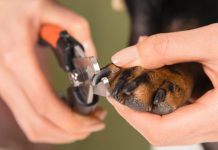 Dog owners are best served by learning how to trim dog nails from the start. However, for many fearful individuals, it is a nerve-wracking ordeal that is better handled by someone else. You might prefer to pay someone else to trim your dog nails, but doing it at home is cheaper and more comforting for an anxious dog. It is important to note that there are several side effects on your dog, not having the nails trimmed for too long.
Dog owners are best served by learning how to trim dog nails from the start. However, for many fearful individuals, it is a nerve-wracking ordeal that is better handled by someone else. You might prefer to pay someone else to trim your dog nails, but doing it at home is cheaper and more comforting for an anxious dog. It is important to note that there are several side effects on your dog, not having the nails trimmed for too long.
If you are a bit squeamish about knowing how to trim dog nails at home, think of the discomfort caused by long dog nails. If you do not help the process along early on, your dog risks far worse outcomes. In this article, you will understand how to safely trim dog nails. You will learn a multipronged approach that is used to; control the temperament of your dog, select the right equipment, handle any mishaps, and properly bond with your pet.
How to Get Your Dog Comfortable
At this point, you have decided to understand what the grooming of nails entails. The biggest challenge when you trim your dog’s nails is your temperament. Why is your mood important when learning how to trim dog nails? The answer is quite simple; dogs are very perceptive animals that can sense tension from their owners. Therefore, giving their nails a trim when you are nervous is a bad idea.
The first step of getting your dog comfortable is to set the mood. This mood is then perceived and copied by the dog. When your dog is relaxed, preferably on a seat by the table, you can initiate contact with their nails. You will notice an instantaneous change in the mood of your dog, especially if this is the first time you are attempting to trim at home.
Mood setting is an important part of your dog’s initial training. Normalizing touching their paws ensures that they get used to this familiar contact and remain calm. Using the perfect balance of treats, praise, and cuddles, you can train your dog to be fine with trimming once in a week.
 To achieve the best results, offer lots of motivation constantly throughout the process. Gently touch the feet of your dog and give praise while offering treats as a distraction and reward. If done correctly, you should be able to touch, hold, and thoroughly ascertain the state of your dog’s nails in a single sitting.
To achieve the best results, offer lots of motivation constantly throughout the process. Gently touch the feet of your dog and give praise while offering treats as a distraction and reward. If done correctly, you should be able to touch, hold, and thoroughly ascertain the state of your dog’s nails in a single sitting.
A spoon of peanut butter or a constant stream of treats also reinforces the behavior and creates a routine for each time you trim dog nails. Ensure your dog is on a comfortable surface without any roughness that may create the need for scratching. Your progress on getting to know how to trim dog nails will be slowed down if you are in a place with multiple other distractions as well.
Here is a seven-step process you can follow to accustom your pet and trim dog nails:
- Show the clippers to the dog; essentially, just let the pup see the nail trimmers. When they get a whiff of it, they will be familiar the next time you are holding it. Do not use it at the first encounter.
- The next step when getting ready for a trim is to initiate contact with their paws. Softly massage the paws on the lower side and help your dog relax.
- The third is to individually check every nail and assess the length of the sensitive parts. Offer lots of treats in this step. Squeeze the toe from below and push on the base of the nail to fully reveal its length.
- Trim part of the nail with the clippers or switch on the grinder so the dog can see how harmless the entire process is. Here, positive behavior conditioning is key.
- Trim deeper while exercising patience as this is a new sensation on the pup. A gentle approach gets you through here.
- Using a grinder should be with moderation to prevent anxiety in your dog. By this point, because your dog has experienced the negative effects of long nails, they will be relieved.
- Treats and rewards at the end of the exercise, followed by a relaxing activity. Allow time for adjustment to the new feeling after trimming. Avoid any strenuous movement to reduce the likelihood of contamination of unnoticed quicks.
In summary, stay calm to inspire calmness in your dog. Be gentle and ensure the entire process is full of reward; a happy experience is easier to grow into the routine. Treats and praise allow the tension and anxiety of trimming to dissipate. Finally, prepare your dog in advance and start to teach your dog while a pup.
Why Cutting Your Dog’s Nails Is Necessary
Some dogs have learned behavior and routine that often grinds up their nails far enough for them to go without trimming. Your dog is unlikely to be one of such. These dogs are often wild or very actively digging up through the soil. The friction in these interactions effectively trims their nails. The truth is, your house pet might not be as active, and its nails may be too long.
What are the dangers of long nails for dogs? Long nails are pressed against the ground when your dog walks. As the nails get longer, the nails prop the toes at odd and unnatural angles. The pressure is exerted on the toes constantly; a painful sensation develops as a result. You may notice a change in how your fur buddy walks almost instantly.
The problem does not stop there. Prolonged contortion at unnatural angles quickly transfers this tension to the tendons. The incessant strain on the tendons and, consequently the muscles of the limbs is a cascade of torture for your dog.
In some rare cases, the overgrown nails cause so much pain that the dogs behave like mountain goats. Mountain goats often lean forward when on a hill. As an evolutionary quirk, dogs instinctively lean forward when their nails touch the ground.
Dog Nail Trimming Explained
As stated earlier, understanding how to properly trim dog nails is a multipronged process. It involves the collection of the right equipment, creating the right environment, and a reward system to enforce the trim lessons learned. In this section, we will get a step by step look at how to trim dog nails.
Step 1 – Collect Equipment
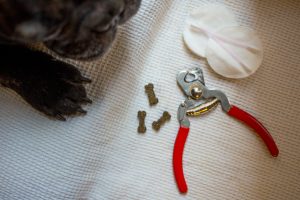 You have the choice of using either grinders, clippers, or a guillotine to trim the nails. Each of these has its perks and downsides. The choice of equipment comes down to the breed of dog, the color of the nails, how large the dog is and how fast you want to trim the nails.
You have the choice of using either grinders, clippers, or a guillotine to trim the nails. Each of these has its perks and downsides. The choice of equipment comes down to the breed of dog, the color of the nails, how large the dog is and how fast you want to trim the nails.
As a beginner, using clippers is advised as this allows you to properly define the trim angle while keeping the likelihood of anxiety low. Clippers are quiet and easier to use. This way, you lower the risk of quicking as you trim the nails.
Grinders are used to trim short nails at a certain length. Stress-free and efficient, grinding nails have to be done often. Grinders are, however terrible for the first few uses as the vibration tends to create anxiety and this discomfort only slows down this process.
Keep a bowl of treats handy should you be inclined to use them. Similar to clippers, grinds have an upside – the risk of hurting your dog is almost nonexistent. Attention intensive and arduous, grinding the nails requires specialized equipment that is meant to trim different types of nails.
The last tool we will critic for your consideration is a guillotine. A guillotine is often inaccurately used by inexperienced dog owners. It hurts the dogs, and the multiple quicking incidences make dogs create a bad association between you and the guillotine touching their paws.
Step 2 – Have a Clear Cutting Range
Touching the paws of your pup from a young age has the added advantage of familiarity. When your dog is comfortable enough with you around its paws, you can easily establish the trim range. The structure of a dog’s nail is such that there is a sensitive part and an insensitive part. The sensitive part is the live nail. It has live blood vessels within to nourish and replenish the supply.
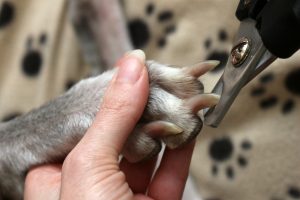 Quicking occurs when you trim the sensitive nail. This causes bleeding, pain, and intense discomfort. Establishing the trim range is meant to identify the location of the tip of the sensitive nail to avoid injury. Using a guillotine makes the process redundant as you cannot reliably trim the nail without crushing it.
Quicking occurs when you trim the sensitive nail. This causes bleeding, pain, and intense discomfort. Establishing the trim range is meant to identify the location of the tip of the sensitive nail to avoid injury. Using a guillotine makes the process redundant as you cannot reliably trim the nail without crushing it.
Different breeds have uniquely colored nails. Dark nails have a noticeable arch that shows the tip of the sensitive nail. Identifying this point is much harder for lighter nail complexions. Press your thumb on the lower side of the toes and push the toe at the top to reveal the entire nail from within the bed and try to see the best trim length.
Owners that start and build a trimming routine early have an easy time here as the sensitive nail slowly retreats when you trim the nails often. Building a sustainable trimming habit progressively eases the difficulty level of the process.
Step 3 – Trim
Unlike human nails, dog nails curl to form an acute angle. Talon like nails is essential for carnivores to hunt. Domesticated dogs have kept this evolutionary advantage. This peculiar form requires a more patient approach to trimming the nails.
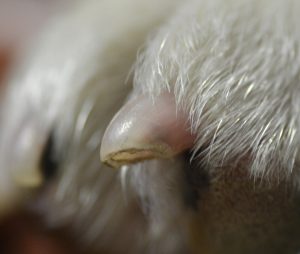 What is the proper technique of how to trim dog nails? After you can see the sensitive nail, establish an inclined trim angle. This will help you avoid the sensitive nail while progressively advancing on the length. As a beginner, start by clipping the tip of the nail. Read the reaction of your dog. Trim some more in the same angle as before, coming from the front.
What is the proper technique of how to trim dog nails? After you can see the sensitive nail, establish an inclined trim angle. This will help you avoid the sensitive nail while progressively advancing on the length. As a beginner, start by clipping the tip of the nail. Read the reaction of your dog. Trim some more in the same angle as before, coming from the front.
Offer a treat and cuddle to ease your dog into it. When you start getting into a flow and are too distracted to offer a treat, use a large snack, your dog can lick while you trim. Affection during this exercise is crucial for all the other times you will have to trim the nails again, whether you do it yourself or have a pro do it for you.
There are two more trim angles. A clipper allows you to trim from the sides and front. After you trim the front, you will notice the nails have two sharp edges. Use the second and third trim angles from the sides and trim those edges off. Many owners may fumble at this stage; the sensitive nail can accidentally get knicked. When this happens, do not worry, many owners go through this before mastering how far to trim dog nails.
Step 4 – Reward Your Dog
Animal behavioral psychology has found that the use of routine and clearly structure reward and punishment systems are effective methods of building and maintaining sustainable animal behavior. Your dog is house trained using a positive reinforcement reward system. Any correct action or routine is completed with a treat.
The dog unknowingly associates the routine with a treat and praise. All these things make the dog happy. Responses associated with certain behavior encourage the routines and make it easier to handle your dog.
Whenever you trim your dog’s nails, reward your dog at every stage of the process. Upon initial contact, offer a treat. Successive stages, including the iterative trims, should all be followed with a treat; this way, your fur baby cannot be opposed to anything. The final step of the trimming is to exercise a lot of patients
What Do I Do If My Dog Bleeds?
You may not know this yet, but you will feel some level of guilt when you quick your dog. Remember, you did not do this on purpose. It is a set back as this makes your dog nervous from the pain. At this point, you should stop for a bit. Distract your pup with treats and carefully put aside the trim equipment.
Bleeding occurs when you trim the sensitive nail. The sensitive nail has many tiny blood vessels within it. A deep trim raptures these vessels and causes bleeding. Thankfully, the bleeding is a slow stream as opposed to a pulsing gush of an artery.
Regardless, the solution is simple. Use sterile equipment or a ball of cotton to wipe away the blood. Quantify the extent of damage in the process. If you have quicked a large part of the sensitive nail, the toe will be sore for a while, and you might be forced to stop for proper attention.
The styptic powder should be applied onto the cut after wiping the blood away. Styptic powder is used to stop the bleeding and prevent wound infection before you seek proper medical advice. There are pencils made with styptic powder for a similar application.
This is not the final solution. It is a stop plug meant to allow you to continue the process of trimming the nails before you see a doctor. Rewards are essential in this part as they distract the dog from the pain and repair any trust that was lost while giving the nails a trim.
Final Thoughts on Dog Nail Trimming
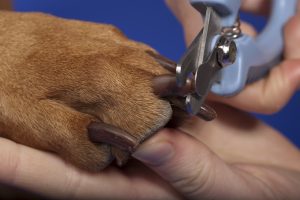 Before you master how to trim dog nails with clippers, there are a couple of other things you need to understand. Breeds have different rates of nail growth and will require you to trim their nails at different intervals. This can be a hurdle for owners of different breeds as they each require you to follow a different cycle. The breed also influences how to trim large dog nails versus smaller dog nails. They may require different equipment in terms of size and efficacy.
Before you master how to trim dog nails with clippers, there are a couple of other things you need to understand. Breeds have different rates of nail growth and will require you to trim their nails at different intervals. This can be a hurdle for owners of different breeds as they each require you to follow a different cycle. The breed also influences how to trim large dog nails versus smaller dog nails. They may require different equipment in terms of size and efficacy.
A regular trim cycle is the last step to the perfect routine. Once a week is sufficient time to take before you trim the nails again. This is ample time between trims to have some level of growth but not too much. You should adjust this timeline based on the growth rates you observe. Twice a month may be enough for your dog.
Note that no fixed length defines how short to trim dog nails. Routine clipping of nails eventually causes sensitive vessels to recede inward. In time, you can trim the nails shorter and closer to the nailbed. Do not forget to clip the dew nails as well.
Essentials for Dog Nail Grooming
These are the items you must have handy while you trim the dog nails. They include precautionary items and additional care tools. The list includes:
- Styptic powder/pencil
We understand that it is not your intention to injure your pup. However, the styptic powder provides a safety net should you need to mitigate any injuries before a vet can have a look at it. Directions for the use of styptic powder and pretty simple; apply a generous amount over the cleaned wound to stop bleeding. The use of styptic powder allows you to continue to trim the nails.
You can use the powder or pencil. The caveat here is that a pencil will require direct contact with the quick involving friction. That is the last thing you need to do on a nail that has been injured during a trim. The powder is friendlier, as it requires zero contact.
- Comfortable grip clippers
The good grip provides precision as you trim the nails of your dog. Ensure you buy clippers of the right size for your pet. A large clipper meant for a Great Dane would be overkill if used on a poodle. Sharp trimmers allow for a cleaner trim.
- Noiseless grinders
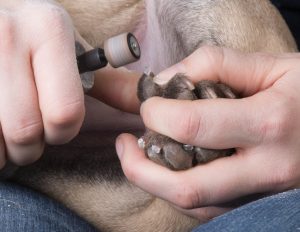 Whereas some manufacturers promise an easy to use a grinder, a quiet grinder is more effective in giving a trim without getting your dog more anxious. Your dog has evolved to be acutely attentive to any sensations on the paw, so you should bear this in mind. A noiseless grinder will allow minimal distraction and give you room to work while you trim the dog’s nails. You can find the best dog nail grinder of 2020 in the latest product reviews.
Whereas some manufacturers promise an easy to use a grinder, a quiet grinder is more effective in giving a trim without getting your dog more anxious. Your dog has evolved to be acutely attentive to any sensations on the paw, so you should bear this in mind. A noiseless grinder will allow minimal distraction and give you room to work while you trim the dog’s nails. You can find the best dog nail grinder of 2020 in the latest product reviews.
- Tiny hair clippers
As you learn how to trim dog nails, you will notice just how quickly the occasional nail trim makes the clippers blunt. Use a tiny hair clipper to chop the hair around the paw and make your work easier.
Knowing how to trim dog nails safely at home a simple process that you can learn with ease. Remember to exercise patience for both of you. Use the right equipment to trim nails, and be sure to see a doctor in case of any complications you encounter. Any time spent with your dog is a good time to bond, so make the most of this trim and have fun.








